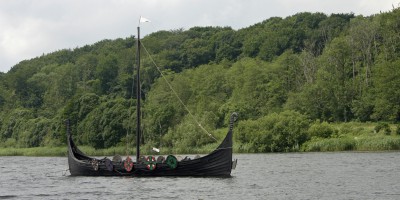 The next part of the hike I walk alone for two days, totaling
The next part of the hike I walk alone for two days, totaling
about 54 km. I start where Niels and I left off last time at the lake Fårup Sø
on the southern outskirts of Jelling. A reconstructed Viking ship floats in the
water and reminds visitors that they have now arrived at the ancient Viking
stronghold.  Jelling is where pagan Viking gods meet Christianity
Jelling is where pagan Viking gods meet Christianity
and where the first king of Denmark was buried. It is considered Denmark’s
birth certificate. This marks where the Danish monarchy and Christianity in
Denmark began. The area is so full of history that it has been designated a
UNESCO World Heritage Site. 
 Let’s start with the burial mounds. The biggest of
Let’s start with the burial mounds. The biggest of
them is the largest burial mound in Denmark and was constructed on top of a
burial mound from the Bronze Age. Two million turf blocks were used to build
it. The other, smaller, burial mound is where Denmark’s first king, Gorm the
Old, was originally buried as a heathen in the year 959. A few years later, his
son Harald Bluetooth moved his father’s remains to give him a Christian burial.
There are remains of a grave chamber that lay in connection with the original wooden
church. Now there is a stone church – back to that later. 
Outside the present church are two rune stones. The
smallest of them was raised by King Gorm the Old in honour of his wife Thyra.
It mentions the name Denmark for the first time. The largest of the stones,
from the year 965, was raised by Harald Bluetooth in honour of his parents, Gorm and Thyra. It
says that Harald won all Denmark and Norway and made the Danes Christian. This
marks the point in time when the Vikings downsized from having many gods (such
as Thor and Odin) to having just one.  The stone also has Scandinavia’s oldest picture of
The stone also has Scandinavia’s oldest picture of
Christ. The same picture adorns the Danish passport. Whether we are religious
or not, we cannot escape the fact that Christianity is an integral part of our
Danish heritage.
So much for the burial mounds and the rune stones. The
area also encompasses an enormous stone ship (350 m). 
Originally, it encircled
the spot where Gorm the Old was buried. The ship ensured that he could sail to
the gods in mythical Valhalla (Valhalla was Odin’s home and where Vikings that
died honourably in battle went to).
Surrounding the two burial mounds and the
stone ship was a 1.4-km long and 4-metre high palisade. It surrounded an area
corresponding to 12 soccer fields (12 hectares). The palisades are now marked with white stones. The size and grandeur of the
whole shebang attest to Gorm the Old’s power. 

Lastly, there is the church. It is one of Denmark’s
very first stone churches, built around 1100. It lies where the original wooden
church built by Harald Bluetooth lay. Although the church is old, not much of
the interior remains from that time It is in fact quite modern with typical
understated, elegant Danish design. A
silver stripe in the floor indicates where Gorm the Old was re-buried.
A replica of a sailing ship hangs from the ceiling.
Numerous queries on my part and hunting around on Google have not given me a
satisfactory reason for the Danish tradition of hanging ships in churches –
just many suppositions. Nevertheless, it is a nice habit. 
Well, folks that was your history lesson for today. I
think it is fascinating to experience hundreds and hundreds of years of history
merely by following a path up through Jutland.

